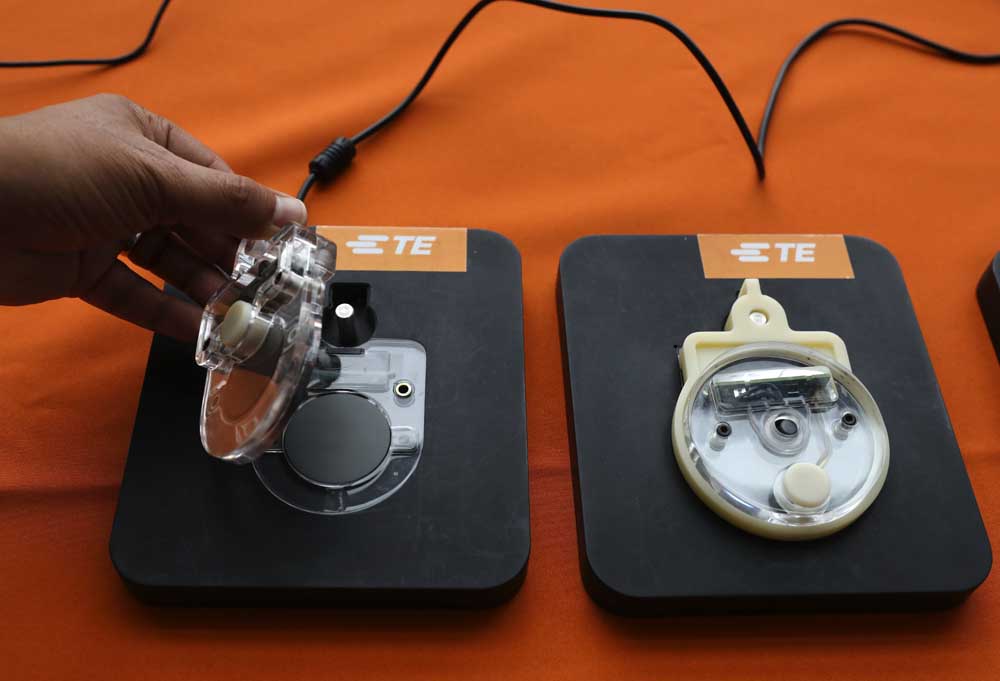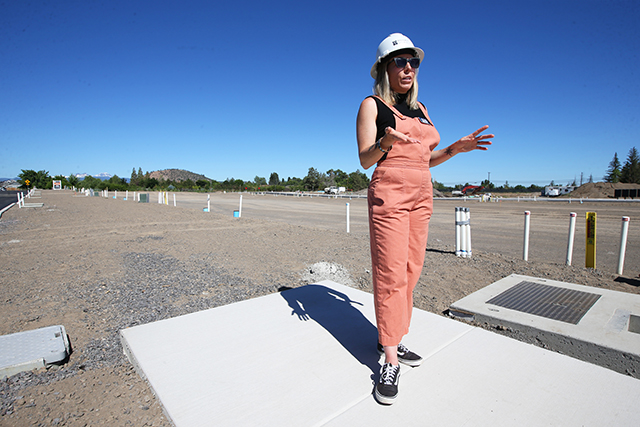Conference highlights rise of the ‘smart kitchen’
Published 5:56 am Thursday, January 11, 2018

- With these connectors - one under a countertop, the other on an appliance - no plugs are needed. (Ken Lambert/The Seattle Times/TNS)
SEATTLE — I have seen the kitchen of the future, and we’re all going to need a lot more counter space.
The Smart Kitchen Summit convened in Seattle recently. The lanyarded crowd swarmed in and out of plenary sessions on topics such as “I, Chef-Bot: Applying AI to the World of Food & Cooking,” and talks like “You Are Eating Software.” The average attendee: white, male, mid-30s, upscale business-casual. The guys wearing suits looked a little quaint. Networking was rampant.
Trending
Around the semicircular mezzanine, up in the air, the gleaming future of the kitchen was arrayed, with different companies presenting the ways they seek to disrupt the food space. (It’s “space” now, not “market,” and disruption, in case you haven’t heard, is a good thing. More vocabulary: “full stack,” “blockchain” and “democratization,” which seems pretty completely divorced from its original meaning.)
If you are hoping for an anthropomorphic kitchen bot that glides around on its wheel-leg, possibly wearing a frilly apron, doing all the things you used to do while you drink a glass of wine and, I don’t know, shop online, I am sorry to disabuse you of your vision. While it seems to be in vogue to refer to them as “robots,” the future of the kitchen looks more like large-ish countertop appliances, and you’re going to need more than one to get everything done.
The Summit atmosphere had a touch of the infomercial about it — with some of the future still in the prototype phase, the scent of venture capital was in the air. I spoke with one entrepreneur, who proved to be from Croatia, about his robot, the GammaChef. “Like homemade meals? Let me cook for you!” the GammaChef’s banner read. The GammaChef has a place for a pot and a stirring attachment; along the top of the machine are embedded Tupperware-esque containers, some refrigerated, to be filled with the ingredients for what the GammaChef is going to cook for you. You still have to prep and chop, though part of the vision is to partner with a meal-kit service to take care of that; the recipe is dictated to the GammaChef via an app. The GammaChef’s human likened it to a self-driving car. “I believe in the future, something like this will be in every home,” he said, not overly evangelically. I said something haltingly about actually liking cooking. “I like to cook!” he replied affably. “But I don’t like to cook every day.”
“My wife used to love to bake,” the overseer of another robot, the PantryChic, told me. Apparently, all the measuring finally got to her — with the PantryChic, you store your dry goods in Tupperware-like SmartCanisters; use an app to choose a recipe; then place the canisters for the recipe, in turn, atop it; and it allots each ingredient out by weight with the push of a button. No more messy measuring cups! And the SmartCanisters can be programmed to let you know when, say, your baking powder is going to expire, or when you need to get more flour. “So your wife loves baking again?” I asked, in an effort to bring it back around. “Yes!” he enthused.
There was all this and much, much more. The GammaChef had a competitor in Oliver, another robot-cooker with a more space-age shape, kind of like an oversized Champagne bucket with clear ingredient-cylinders poking out of the top. The PantryChic could hook up with June, “the world’s only intelligent convection oven,” though their apps might not be compatible. In the beverage space, among other countertop-taker-uppers, there was a unit that reproduces different craft beers for you, obviating those troublesome trips to bars; a Bluetooth-enabled electric pour-over kettle; and an also-Bluetooth-enabled Keurig-style chai-maker.
I spoke with a fellow demonstrating a refrigerator equipped with a video screen that showed me standing there, looking at it, although it also could look within. He showed me how we could take a Heineken out, and the fridge, smartly, would know so, registering the loss on its display. Then, in the bright future, it would be not only capable of recognizing you as the one who always takes the last beer, but capable of ordering more to prevent that. “Neat!” I said somewhat weakly.
Trending
Solving a problem that doesn’t need solving
Have you seen the episode of “Silicon Valley” with the smart fridge? Its video screen shows what’s inside — just like, the character Gilfoyle notes derisively, the nearby fridge with a glass door (or, you know, opening the fridge). It has an app, “So you can actually watch the food on your phone,” Dinesh marvels. All it needs to do, Gilfoyle says with his signature deadpan hostility, taking a bottle from the door, is keep his beer cold. “Mmm! You’re running low on beer!” the fridge’s disembodied voice chirps, unctuously casual. Objecting to the machine’s verbal tics and to this turn of progress as a whole, Gilfoyle says, “Humans are (expletive). This thing is addressing problems that don’t exist. It’s solutionism at its worst.” In an act of revenge, he hacks the fridge, which later uploads his hack to all its fridge-brethren everywhere. Cut to an appliance store with a line of fridges, each with a Gilfoyle-selected video of a mime mimicking a sex act running on its screen.
Cooking itself, for those of us who’ve learned to love it, isn’t just a means to an end. Using the tools connects us to memories and feelings, the smell of the butter starting to brown, the sound of the pot of water beginning to burble, the stirring with the wooden spoon. At the beginning, it can be intimidating — are you doing it right? It can, indubitably, be frustrating — I did everything right, so why is my cake so horribly dry? But we make mistakes, and learn from them, and share the results, just like life. Unlike life, cooking just gets easier, becoming a literally nourishing friend who’ll be with you till close to the end.
For those who don’t like to cook — or those who want a night off — does loading up a robot to cook for you make more sense than any of the myriad services in the delivery space? Or something like Munchery, which brings you a dinner that’s ready to heat? Or Josephine, where someone in your neighborhood makes your supper for you? What about a restaurant? Or a can of soup?
Advocation from stars
Every conference worth its salt has its hired star power. The Smart Kitchen Summit featured Tyler Florence, of Food Network fame. “Recipes are dead,” he declared dramatically beneath a slide of a hamburger with a knife stuck through it reading, “Recipes are dead.” His vision of the future, courtesy of Silicon Valley startup Innit, is an “incredibly personalized” artificially intelligent kitchen “platform,” getting to know you better and better all the time, delivering “micro cooking content units” rather than now-deceased recipes.
The AI would already know what food you had in the house, or you could tell it, e.g., “What can I cook tonight? I’ve got some chicken …” Florence said, “I’m getting goose bumps even thinking about it.”
The audience who’d have the raw materials for a meal, actually want to cook it and have no idea how seems like a small cross-section of humanity. And what happens when your kitchen goes down, and you’re left standing there holding a green pepper, shouting into the void?
Later the same day, “Top Chef” champ Michael Voltaggio talked about starting out as a busboy at age 15 at a Holiday Inn and how, given a chance to arrange catering platters, he made palm trees with carrot trunks and green-pepper fronds. He talked about learning traditional tapas from Jose Andres back in the day, about sometimes answering the phone to personally take reservations now. He said things like, “I think chefs need to get back in their kitchens and start cooking more food,” and, “My goal is to stay as close to the stove for as long as possible.”
Voltaggio talked about technology in terms of furthering the discourse about food; more practically, he’d like to see it used to obviate that awkward moment when the check comes, and to convey information about ingredients and allergens. He said that he and others — Roy Choi, Nancy Silverton — recently used technology to raise $100,000 in a matter of a few hours to help those in need in Mexico and Puerto Rico. “Let’s use it to do more good,” he said. He didn’t seem to be selling anything.
Doing good wasn’t much on the agenda elsewhere. In the sessions I attended, I heard food waste mentioned, in passing, once. The potential for ensuring food safety and transparency in sourcing went unremarked upon, from what I heard. The ways in which the data your kitchen robots gather might be used seemed to be cause for celebration, not questioning. I heard unreassuring blanket assurances that matters of technological security were, of course, being considered along the way.
The “democratization” bandied about seemed to mean access to more technology, more information, more ease and more fun — for those who can afford it. Yes, the robots will improve and the cost will come down, but is it too low-tech to point out that there are still so many people, even here in the United States of America, who don’t have enough to eat?
Microsoft’s Steve Abrahams spoke of the desire not just for recipes but to “become comfortable with food,” the capacity of technology to deliver a cooking lesson from a famous chef, the sound of the snap of a carrot. Jay Holzer of Tastemade made people laugh and also talked seriously about the limitations of technology — how “to truly connect with your food, you have to understand what you’re doing” on a level beyond the depth of a screen.








